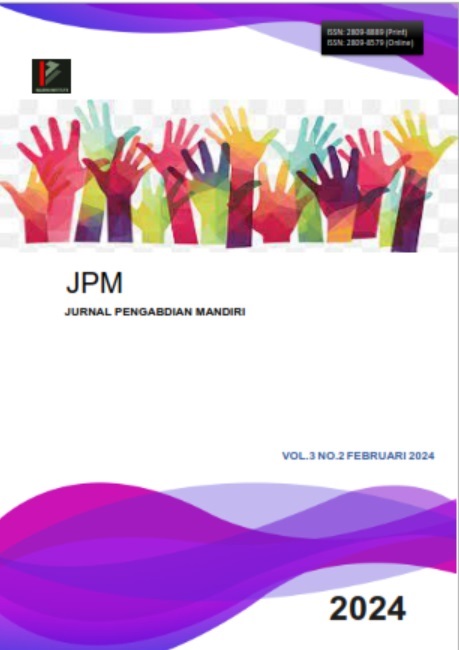SKRINING FAKTOR RISIKO GANGGUAN KESEHATAN GURU DAN TENAGA PENDIDIK SMP DAN SMA “X”, BANDUNG
DOI:
https://doi.org/10.53625/jpm.v3i2.7513Keywords:
Guru, Tendik, Skrining, Sindrom MetabolicAbstract
Di era modernisasi ini, pola makan dan pola aktivitas fisik masyarakat sudah banyak berubah. Perubahan ini selaras pula dengan perubahan pola penyakit pada suatu komunitas termasuk pada masyarakat Indonesia. Guru dan karyawan SMP & SMA “X” merupakan salah satu populasi masyarakat dengan berbagai keanekaragaman umur, pola makan dan pola aktivitas fisik. Melalui observasi yang selama ini dilakukan, tidak sedikit diantaranya memiliki kebiasaan makan dan aktivitas fisik yang kurang baik. Pemeriksaan kesehatan berkala pun yang selayaknya didapat oleh karyawan belum pernah diadakan di SMP/SMA”X”. Berdasarkan hal tersebut maka dilakukan pengabdian masyarakat yang bertujuan untuk skrining kesehatan untuk dapat mengetahui faktor risiko penyakit metabolik melalui pemeriksaan gula darah, kolesterol, asam urat, IMT (indeks masa tubuh) dan tekanan darah. Berdasarkan hasil pemeriksaan didapatkan 2% gula darah tinggi, 35% kolesterol tinggi dan 16% asam urat tinggi. Tindak lanjut dari hal tersebut, dilakukan edukasi kepada guru/tendik tersebut dan diberikan kesempatan bagi yang bersangkutan untuk berkonsultasi langsung kepada dokter ahli gizi klinik dan dokter penyakit dalam yang telah ditunjuk.
References
Alberti, K. G., Eckel, R. H., Grundy, S. M., Zimmet, P. Z., Cleeman, J. I., Donato, K. A., Fruchart, J. C., James, W. P., Loria, C. M., & Smith, S. C. Jr. (2009). Harmonizing the metabolic syndrome: a joint interim statement of the International Diabetes Federation Task Force on Epidemiology and Prevention; National Heart, Lung, and Blood Institute; American Heart Association; World Heart Federation; International Atherosclerosis Society; and International Association for the Study of Obesity. Circulation, 120(16), 1640-1645.
Beltrán-Sánchez H, Harhay MO, Harhay MM, McElligott S (August 2013). "Prevalence and trends of metabolic syndrome in the adult U.S. population, 1999–2010". Journal of the American College of Cardiology. 62 (8): 697703. doi:10.1016/j.jacc.2013.05.064. PMC 3756561 . PMID 23810877.
Di Marzo V, Fontana A, Cadas H, et al. (Dec 1994). "Formation and inactivation of endogenous cannabinoid anandamide in central neurons". Nature (Submitted manuscript). 372 (6507): 686–91. Bibcode:1994Natur.372..686D. doi:10.1038/372686a0. PMID 7990962.
Falkner B, Cossrow ND (July 2014). "Prevalence of metabolic syndrome and obesity-associated hypertension in the racial ethnic minorities of the United States". Current Hypertension Reports. 16 (7): 449. doi:10.1007/s11906-014-0449-5. PMC 4083846 . PMID 24819559.
Feinman, R. D; Pogozelski, W. K; Astrup, A; Bernstein, R. K; Fine, E. J; Westman, E. C; Accurso, A; Frassetto, L; Gower, B. A (2015). "Dietary carbohydrate restriction as the first approach in diabetes management: Critical review and evidence base". Nutrition. 31 (1): 113. doi:10.1016/j.nut.2014.06.011. PMID 25287761
Felizola, Saulo JA (2015). "Ursolic acid in experimental models and human subjects: Potential as an anti-obesity/overweight treatment?". doi:10.13140/RG.2.1.4502.4804.
Fukuchi S, Hamaguchi K, Seike M, Himeno K, Sakata T, Yoshimatsu H (June 2004). "Role of fatty acid composition in the development of metabolic disorders in sucrose-induced obese rats". Experimental Biology and Medicine. 229 (6): 48693. doi:10.1177/153537020422900606. PMID 15169967.
Gatta-Cherifi, Blandine; Cota, Daniela (2015). "Endocannabinoids and Metabolic Disorders". Endocannabinoids. Handbook of Experimental Pharmacology. 231. hlm. 367–91. doi:10.1007/978-3-319-20825-1_13. ISBN 978-3-319-20824-4. PMID 26408168.
Herningtyas EH, Ng TS. Prevalence and distribution of metabolic syndrome and its components among provinces and ethnic groups in Indonesia. BMC Public Health. 2019 Apr 3;19(1):377. doi: 10.1186/s12889-019-6711-7. PMID: 30943932; PMCID: PMC6448251.
International Diabetes Federation. The IDF Consensus Worldwide Definition of The Metabolic Syndrome. Brussels: International Diabetes Federation, 2006.
Kaur J (2014). "A comprehensive review on metabolic syndrome". Cardiology Research and Practice. 2014: 1–21. doi:10.1155/2014/943162. PMC 3966331 . PMID 24711954.
Moghadam-Ahmadi A, Soltani N, Ayoobi F, et al. Association between metabolic syndrome and stroke: a populationbased cohort study. BMC Endocr Disord; 23. Epub ahead of print 1 December 2023. DOI: 10.1186/s12902-023-01383-6.
Srikanthan, K; Feyh, A; Visweshwar, H; Shapiro, J. I; Sodhi, K (2016). "Systematic Review of Metabolic Syndrome Biomarkers: A Panel for Early Detection, Management, and Risk Stratification in the West Virginian Population". International Journal of Medical Sciences. 13 (1): 25–38. doi:10.7150/ijms.13800. PMC 4716817 . PMID 26816492.
Stern MP, Williams K, González-Villalpando C, et al. Does the metabolic-syndrome improve identification of individuals at risk of type 2 diabetes and/or cardiovascular disease? Diabetes Care 2004; 27: 2676–2681.
Urcotte C, Chouinard F, Lefebvre JS, Flamand N (June 2015). "Regulation of inflammation by cannabinoids, the endocannabinoids 2-arachidonoyl-glycerol and arachidonoyl-ethanolamide, and their metabolites". Journal of Leukocyte Biology. 97 (6): 1049–70. doi:10.1189/jlb.3RU0115-021R. PMID 25877930.
Vemuri VK, Janero DR, Makriyannis A (March 2008). "Pharmacotherapeutic targeting of the endocannabinoid signaling system: drugs for obesity and the metabolic syndrome". Physiology & Behavior. 93 (4–5): 671–86. doi:10.1016/j.physbeh.2007.11.012. PMC 3681125 . PMID 18155257.
Downloads
Published
How to Cite
Issue
Section
License
Copyright (c) 2024 JURNAL PENGABDIAN MANDIRI

This work is licensed under a Creative Commons Attribution-NonCommercial-NoDerivatives 4.0 International License.











